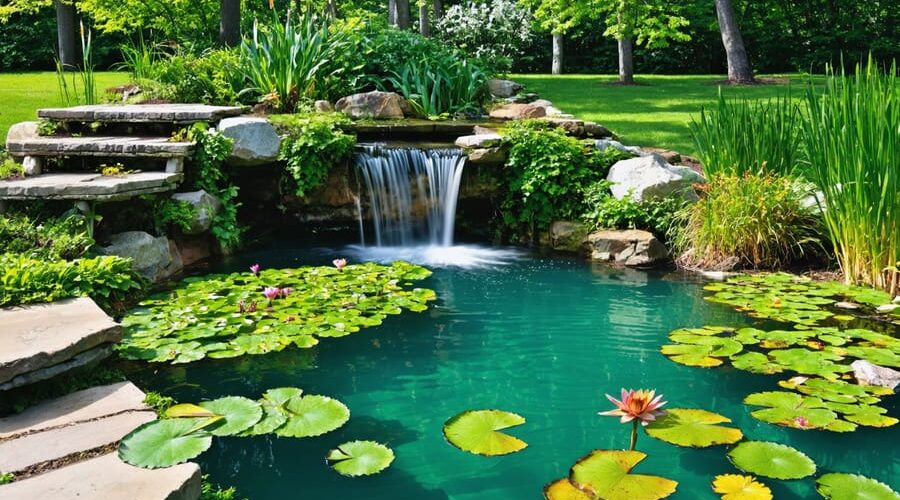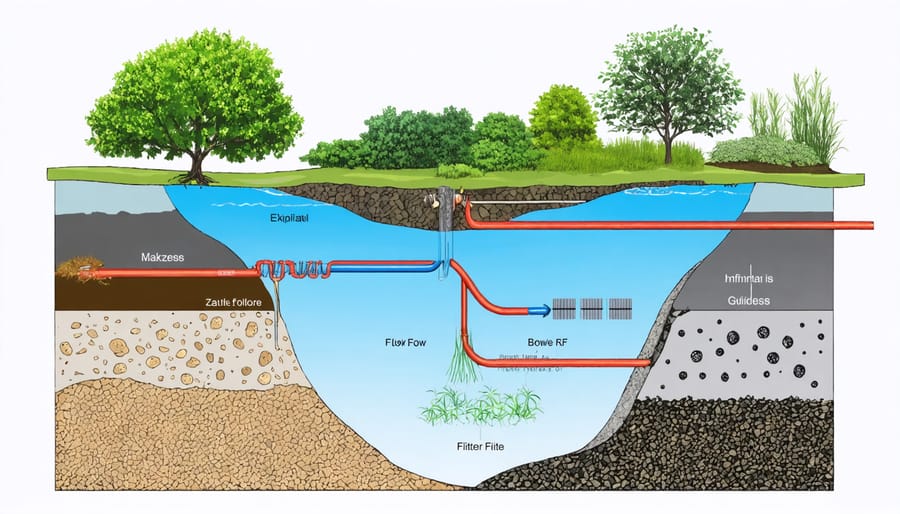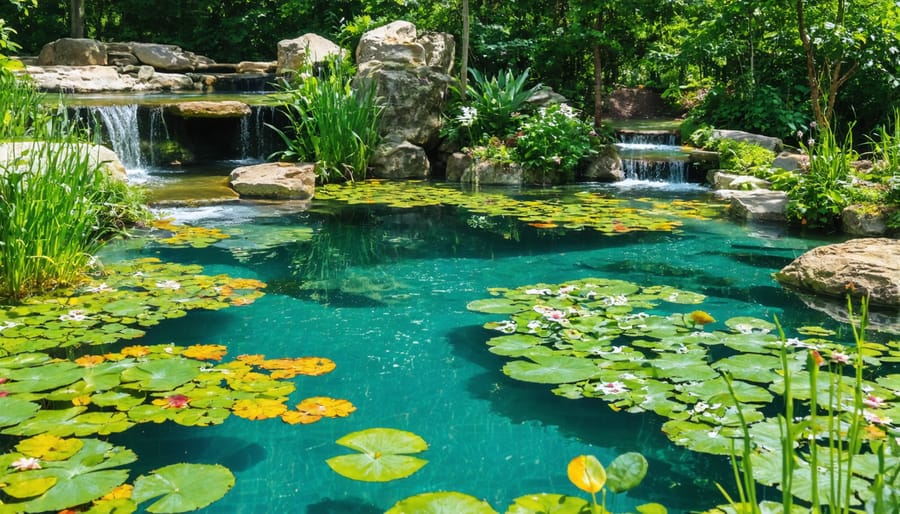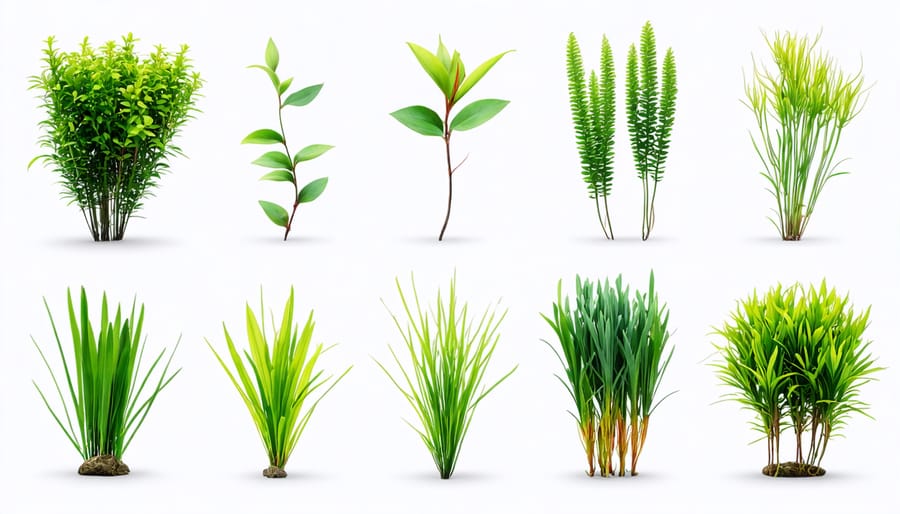
Transform Your Pond with a Biofiltration System That Actually Works
Transform your backyard into a thriving ecosystem with a biofiltration pond – nature’s ingenious solution for crystal-clear water and sustainable landscaping. These remarkable water features combine the beauty of a traditional pond with advanced biological filtration systems that harness beneficial bacteria, aquatic plants, and natural processes to maintain pristine water quality.
Unlike conventional filtration methods, biofiltration ponds create a complete ecological cycle where every element serves multiple purposes. Carefully selected aquatic plants not only add visual appeal but also absorb excess nutrients, while specialized filter media provides the perfect habitat for beneficial microorganisms that break down waste naturally. This self-sustaining system requires minimal maintenance while offering maximum environmental benefits.
Whether you’re a passionate gardener looking to add a water feature or an environmentally conscious homeowner seeking sustainable solutions, a biofiltration pond offers the perfect blend of functionality and natural beauty. From supporting local wildlife to reducing water consumption and creating a serene outdoor sanctuary, these innovative systems represent the future of sustainable water management in residential landscapes.
Learn how these remarkable systems can revolutionize your outdoor space while contributing to a healthier environment – all while creating a stunning focal point that will be the envy of your neighborhood.
How Biofiltration Ponds Work Their Magic
The Natural Cleaning Process
The heart of a biofiltration pond lies in its incredible natural cleaning process, powered by beneficial bacteria that work tirelessly to maintain water quality. These microscopic heroes form colonies on every surface in your pond, from the filter media to plant roots and even the pond walls.
Think of these bacteria as nature’s housekeepers. They break down fish waste, uneaten food, and dead plant material through a process called biological filtration. The most important players are two types of bacteria: one group converts harmful ammonia into nitrites, while another transforms these nitrites into less harmful nitrates that plants can use as fertilizer.
This natural cycle creates a self-sustaining ecosystem where waste becomes food for plants. The bacteria thrive in oxygen-rich environments, which is why proper water circulation is so important. They work best when water temperatures are between 45-85°F, and they become more active during warmer months.
To help these beneficial bacteria flourish, avoid using harsh chemicals in your pond, as these can harm or kill the bacterial colonies that keep your water clean and healthy.
Key Components of a Biofiltration System
A successful biofiltration pond relies on three key components working together in harmony. The first is the filter media, which provides a home for beneficial bacteria and helps trap debris. Common materials include lava rock, bio-balls, or specialized filters for small water gardens that offer maximum surface area for bacterial growth.
The second component is aquatic plants, which play a vital role in nutrient absorption and water purification. Water lilies, rushes, and marsh plants not only look beautiful but also help remove excess nutrients that could otherwise feed algae. Their roots create additional surface area for beneficial bacteria while providing shelter for pond life.
The star players of any biofiltration system are the beneficial bacteria. These microscopic helpers break down fish waste, fallen leaves, and other organic matter into less harmful compounds. They naturally colonize the filter media and plant roots, creating a living cleanup crew that works 24/7 to keep your pond water crystal clear. The key is providing enough surface area through filter media and plants to support a thriving bacterial colony.

Design Your Perfect Biofiltration Pond
Sizing Your System Right
Getting your biofiltration pond size right is crucial for maintaining healthy water and happy fish. A good rule of thumb is to make your filter system about 10-15% of your total pond volume. For example, if you have a 1,000-gallon pond, aim for a filtration system between 100-150 gallons.
To calculate your pond’s volume in gallons, multiply length × width × average depth (in feet), then multiply by 7.48. For circular ponds, use this formula: π × radius² × depth × 7.48.
When it comes to fish load, consider that each inch of fish typically needs about 10 gallons of water. So, if you plan to keep ten 6-inch koi, you’ll need at least 600 gallons of water. It’s better to err on the generous side with filtration – you can’t really over-filter, but under-filtering can lead to water quality issues.
For optimal results, factor in these additional considerations:
– Add 20% more filtration capacity if you have heavy fish stock
– Increase capacity by 15% in areas with full sun exposure
– Consider seasonal variations and plant load
– Plan for future fish growth
Remember, a properly sized system will require less maintenance and provide better water quality for your aquatic ecosystem. Start with these calculations, but don’t hesitate to go bigger if you’re unsure – it’s always better to have extra filtering capacity than not enough.
Choosing the Best Location
Selecting the perfect spot for your biofiltration pond is crucial for both its effectiveness and your enjoyment. The ideal location should be relatively level, with a slight slope to aid water circulation. Avoid placing your pond under trees if possible, as falling leaves can overwhelm the filtration system and create extra maintenance work.
Consider the natural water flow in your yard – you’ll want to position the pond where it can naturally collect runoff while avoiding areas prone to flooding. The pond should receive partial sunlight, ideally morning sun and afternoon shade, to maintain healthy water temperatures and prevent excessive algae growth.
Distance from your home matters too. While you’ll want the pond close enough to enjoy the view and sound of flowing water, keep it at least 10 feet away from building foundations to prevent any potential water damage. Consider your power source as well – you’ll need electricity for pumps and other equipment, so plan accordingly.
When integrating with an existing pond, position the biofiltration system at a slightly higher elevation. This allows gravity to help move filtered water back into the main pond, reducing the workload on your pump. Remember to leave enough space around the edges for maintenance access and future plantings.
For the best results, conduct a simple soil percolation test in your chosen location to ensure proper drainage. This small step can save you lots of trouble down the road.

Essential Materials and Equipment
To create an effective biofiltration pond, you’ll need several key components that work together to maintain a healthy ecosystem. Let’s start with the basics of natural pond construction materials:
First, you’ll need a reliable pond liner (EPDM rubber or PVC) to prevent water seepage, along with protective underlay fabric to shield the liner from punctures. For the filtration system, gather mechanical filter media like foam mats and bio-balls, which provide surface area for beneficial bacteria to grow.
Essential equipment includes:
– A pond pump sized appropriately for your water volume
– UV clarifier to control algae
– Skimmer box to catch surface debris
– Bottom drain for collecting settled waste
– Aeration system (air pump and diffusers)
For the biological components, you’ll need:
– Aquatic plants (both submerged and marginal)
– Beneficial bacteria starter culture
– Natural filter media (lava rock or ceramic rings)
– Clean gravel for plant beds
Don’t forget basic tools like:
– Garden spade and shovel
– Spirit level
– Measuring tape
– Garden hose
– Water testing kit
These materials ensure proper filtration while maintaining the pond’s natural balance. Start with quality components to avoid future problems and ensure your biofiltration system works effectively from day one.
Maintaining Your Biofiltration System
Regular Maintenance Schedule
Regular water feature maintenance is essential for keeping your biofiltration pond healthy and effective. Here’s a simple timeline to follow throughout the year:
Monthly Tasks:
– Check water levels and top up if needed
– Remove any visible debris from the surface
– Inspect plants for signs of disease or overgrowth
– Test water quality (pH, ammonia, nitrates)
– Clean pump pre-filters
Quarterly Tasks (Every 3 Months):
– Trim back excessive plant growth
– Clean the pond edges
– Check pump performance
– Remove accumulated sediment
– Inspect filtration media
Bi-Annual Tasks (Spring and Fall):
– Deep clean biological filters
– Divide and replant overgrown aquatic plants
– Check for liner damage
– Clean out accumulated sludge
– Prune surrounding vegetation
Annual Tasks:
– Complete system inspection
– Replace worn filter media
– Deep clean the entire pond
– Update plant arrangements
– Check and repair pump systems
Remember to keep a maintenance log to track tasks and water quality readings. Adjust this schedule based on your specific pond conditions and local climate. During growing seasons (spring and summer), you might need to increase the frequency of certain tasks. In winter, reduce maintenance but continue monitoring water quality and removing debris.
Pro tip: Keep basic maintenance tools handy, including a pond net, water testing kit, and pruning shears. This makes routine tasks quicker and easier to complete.
Common Problems and Solutions
Even well-maintained biofiltration ponds can experience occasional issues, but most are easily solved with the right approach. One common problem is excessive algae growth, which often occurs due to nutrient imbalances. Adding more plants to your pond and reducing fish feeding can help restore balance naturally.
Poor water clarity is another frequent concern. If your pond water remains cloudy despite filtration, check that your pump size matches your pond volume and consider adding beneficial bacteria to boost the biological filtration process. A green tinge usually indicates suspended algae, while brown or gray cloudiness might mean excess sediment.
Unpleasant odors typically signal low oxygen levels or decomposing organic matter. Increase aeration by adding a waterfall feature or air pump, and remove dead plant material promptly. Regular skimming helps prevent debris accumulation that can lead to these issues.
Some pond owners struggle with maintaining proper bacterial colonies. If your biological filtration isn’t performing well, check water temperature and pH levels, as these factors significantly impact bacterial activity. Avoid using chemical treatments that could harm beneficial bacteria, and ensure your filter media isn’t being cleaned too frequently.
Seasonal challenges like leaf accumulation in fall can overwhelm your system. Installing a pond net during these periods helps prevent excess organic matter from entering the filtration system and maintains optimal performance year-round.
Plant Selection for Maximum Filtration
Top Performing Filter Plants
When choosing plants for your biofiltration pond, certain species excel at filtering water while adding beauty to your water garden paradise. Here are some top performers to consider:
Cattails are natural water purifiers, removing excess nutrients and heavy metals through their extensive root systems. While they’re aggressive growers, they’re incredibly effective at filtering water.
Water Iris adds elegant beauty while working hard to filter pond water. These hardy plants thrive in shallow water and help remove nitrogen and phosphates, making them perfect for the edges of your pond.
Rushes and Sedges are excellent choices for creating a natural filtering barrier. These grass-like plants are low-maintenance and effectively trap debris while absorbing excess nutrients from the water.
Water Lilies not only provide stunning flowers but also offer shade that helps control algae growth. Their floating leaves reduce sunlight penetration while their roots help filter the water.
Hornwort, a submerged plant, is particularly effective at oxygenating water and removing excess nutrients. It grows freely in the water and requires minimal care while providing excellent filtration benefits.
Remember to include a mix of these plants at different depths for the most effective filtration. Start with a few varieties and add more as needed based on your pond’s specific requirements.

Planting and Care Tips
When planting your biofiltration pond, start by selecting a variety of aquatic plants that thrive in your climate zone. Place taller plants like cattails and rushes at the deeper end, while shorter species like marsh marigolds work well in shallow areas. Space plants about 18 inches apart to allow for growth and proper water flow.
Begin planting in spring when water temperatures reach above 50°F (10°C). Carefully remove plants from their containers and place them in planting baskets filled with aquatic soil. Add a layer of gravel on top to prevent soil from floating away. Submerge each basket to its recommended depth, using stones or bricks to achieve the right height if needed.
Maintain your filter plants by trimming dead foliage regularly and dividing overcrowded plants every 2-3 years. During growing season, fertilize sparingly with aquatic plant tablets pressed into the soil. Monitor water levels and top up during dry spells to keep plants healthy.
In winter, leave hardy plants in place but cut back dead growth. If you live in a cold climate, move tropical species indoors. Check plants monthly for signs of disease or pest problems, and remove any algae buildup around the plants’ bases.
Remember that establishing a healthy plant system takes time – usually one full growing season. Be patient and consistent with maintenance for the best results.
Biofiltration ponds offer an elegant, eco-friendly solution for maintaining crystal-clear water while creating a thriving ecosystem in your backyard. By implementing these natural filtering systems, you’ll not only enhance your pond’s water quality but also create a beautiful, low-maintenance water feature that supports local wildlife. Whether you’re starting from scratch or upgrading an existing pond, the benefits of biofiltration are well worth the initial setup effort. Remember to start small, monitor your system regularly, and adjust as needed. With proper planning and maintenance, your biofiltration pond will reward you with years of enjoyment, providing a peaceful retreat while doing its part to protect our environment. Why not take the first step today toward creating your own naturally balanced aquatic paradise?
